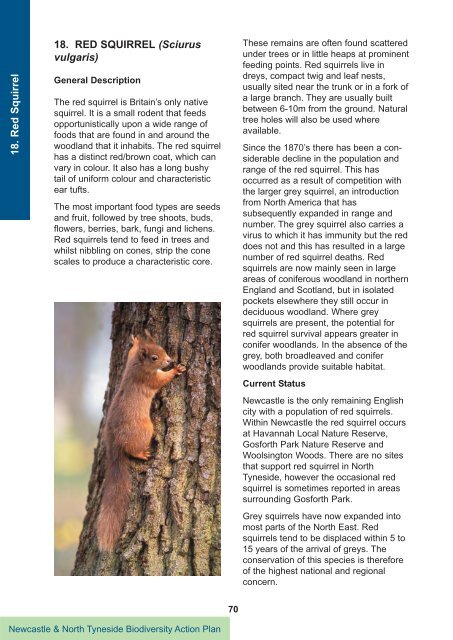III. Species Action Plans - Newcastle City Council
III. Species Action Plans - Newcastle City Council
III. Species Action Plans - Newcastle City Council
You also want an ePaper? Increase the reach of your titles
YUMPU automatically turns print PDFs into web optimized ePapers that Google loves.
18. Red Squirrel<br />
18. RED SQUIRREL (Sciurus<br />
vulgaris)<br />
General Description<br />
The red squirrel is Britain’s only native<br />
squirrel. It is a small rodent that feeds<br />
opportunistically upon a wide range of<br />
foods that are found in and around the<br />
woodland that it inhabits. The red squirrel<br />
has a distinct red/brown coat, which can<br />
vary in colour. It also has a long bushy<br />
tail of uniform colour and characteristic<br />
ear tufts.<br />
The most important food types are seeds<br />
and fruit, followed by tree shoots, buds,<br />
flowers, berries, bark, fungi and lichens.<br />
Red squirrels tend to feed in trees and<br />
whilst nibbling on cones, strip the cone<br />
scales to produce a characteristic core.<br />
<strong>Newcastle</strong> & North Tyneside Biodiversity <strong>Action</strong> Plan<br />
70<br />
These remains are often found scattered<br />
under trees or in little heaps at prominent<br />
feeding points. Red squirrels live in<br />
dreys, compact twig and leaf nests,<br />
usually sited near the trunk or in a fork of<br />
a large branch. They are usually built<br />
between 6-10m from the ground. Natural<br />
tree holes will also be used where<br />
available.<br />
Since the 1870’s there has been a considerable<br />
decline in the population and<br />
range of the red squirrel. This has<br />
occurred as a result of competition with<br />
the larger grey squirrel, an introduction<br />
from North America that has<br />
subsequently expanded in range and<br />
number. The grey squirrel also carries a<br />
virus to which it has immunity but the red<br />
does not and this has resulted in a large<br />
number of red squirrel deaths. Red<br />
squirrels are now mainly seen in large<br />
areas of coniferous woodland in northern<br />
England and Scotland, but in isolated<br />
pockets elsewhere they still occur in<br />
deciduous woodland. Where grey<br />
squirrels are present, the potential for<br />
red squirrel survival appears greater in<br />
conifer woodlands. In the absence of the<br />
grey, both broadleaved and conifer<br />
woodlands provide suitable habitat.<br />
Current Status<br />
<strong>Newcastle</strong> is the only remaining English<br />
city with a population of red squirrels.<br />
Within <strong>Newcastle</strong> the red squirrel occurs<br />
at Havannah Local Nature Reserve,<br />
Gosforth Park Nature Reserve and<br />
Woolsington Woods. There are no sites<br />
that support red squirrel in North<br />
Tyneside, however the occasional red<br />
squirrel is sometimes reported in areas<br />
surrounding Gosforth Park.<br />
Grey squirrels have now expanded into<br />
most parts of the North East. Red<br />
squirrels tend to be displaced within 5 to<br />
15 years of the arrival of greys. The<br />
conservation of this species is therefore<br />
of the highest national and regional<br />
concern.

















